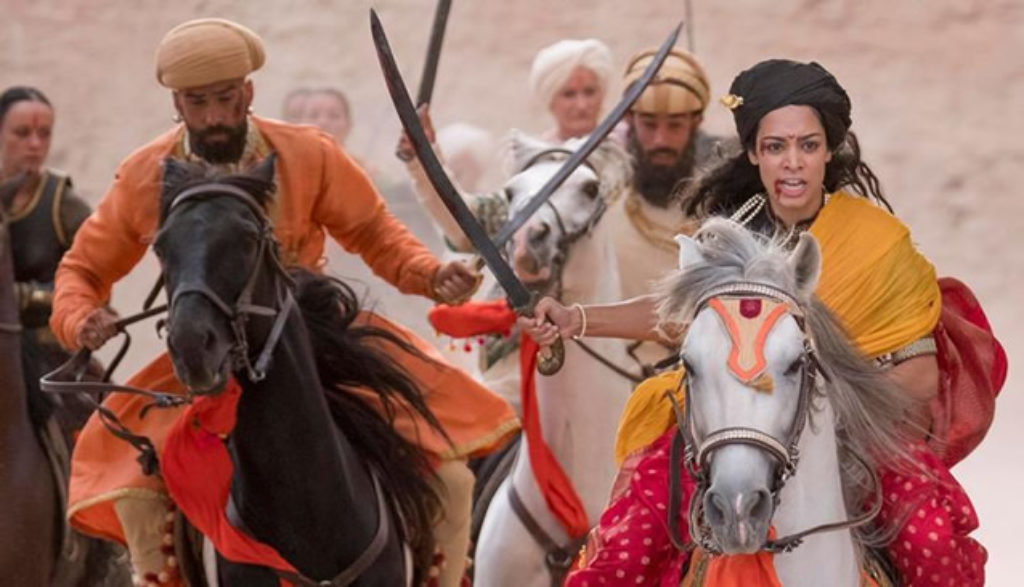
The East India Trading Company was established in the 1600s, supposedly (as its name suggests) for the purpose of commerce. But what began as a British joint-stock trading company evolved over the years into a colonial presence, with the British warring for ever-greater control of the Indian subcontinent.
By 1858, prominence and power had become the prime objectives for Britain in India. And many of the country’s people suffered under British rule as the colonial power proceeded with the ongoing annexation of many states’ territories.
But not every state could be easily captured and assimilated into the ever-expanding British empire. That was especially true of one particular city and its surrounding territory, Jhansi, thanks to the rule of Rani Lakshmibai, its 29-year-old warrior queen.
Trained for battle from a young age, Rani (a title meaning queen) Lakshmibai (her name) was a fierce woman who vowed to protect her people and her land at all costs. Raising up a militia of mostly women, Rani led her soldiers into battle against the British in 1858.
Fighting valiantly, Rani Lakshmibai became a symbol of hope and resistance for the Indian people nationwide. And although she was killed on June 18th, 1858, her brave legacy inspired a thirst for freedom. That thirst eventually helped India to gain its independence from British rule in 1947.
As you’ve likely guessed by now, The Warrior Queen of Jhansi recounts Lakshmibai’s story, one that frames Jhansi and her people as oppressed victims battling back against the evils and excesses of British colonialism.
Rani Lakshmibai is depicted here as a warrior at heart. From a young age, her father taught her how to wield a sword and use a bow and arrow to protect herself. And just as she is a warrior on the outside, she is also a warrior on the inside, too: Lakshmibai is fiercely loyal to her people, kind, brave, selfless and just. She always clings to her convictions, even when facing death. And she believes deeply in the importance of doing one’s duty. The Rani also values human life, showing her maidservants dignity and respect when others would have ignored them and viewed them as being somehow less valuable.
Lakshmibai and her husband adopt their young nephew to ensure an heir for Jhansi (although the adoption is ignored by British officials). She teaches her adopted son that a prince is defined “by his actions” and must be a kind, true example to his people.
After her husband passes, Lakshmibai chooses not to shave her head, defying tradition and declaring that she will not drown in her status as a widow.
Many people surround the Rani (including her father and closest allies), supporting her, sacrificing their own lives to save hers and constantly encouraging her.
A British officer, Major Ellis, reveres the Rani to the point of infatuation. Although he holds his post in the British army, he is quick to come to her rescue and defense. He also fights for the dignity of the Indian natives, urging the British to see that they are to be treated with honor and respect.
The Queen of England, as portrayed in this film, seems genuinely concerned with India’s welfare and wants little bloodshed. She seems to be caught up in a war despite her desire to avoid it.
Rani Lakshmibai, along with other Indian men and women, chants prayers in Hindi for protection and peace. Lakshmibai is blessed by her husband, and he tells her “our ancestors’ blessings will be with you always.” She is called “most pious” as she goes to the temple to pray before battle. She also encourages her soldiers to unite “in one incarnation” as “Freedom Fighters” and calls on the “goddess of Durga,” the Hindu goddess of war, for success in battle. The Rani shoots her injured horse to “release its soul.”
Various statues of Buddha are scattered throughout the kingdom of Jhansi. A British soldier comments that it’s important to bless his food and ward off evil spirits. An Indian native tries to tell a British official that all world religions urge peace.
Muslims and Hindus are deeply offended when the British begin to use pig fat in their guns and the Indians are forced to taste it, as it’s against their religious customs.
The British believe that it is their duty to convert Indians to Christianity.
The Rani is married off at the age of 15. A few years later, she conceives a baby boy.
A few Indian women wear saris that reveal their stomachs as they dance for a group of men. A female servant says she wants to intoxicate a man with her looks.
British soldiers, who are all part of the East India Trading Company as well, pillage and burn villages that do not bow to Britain’s rule as trade becomes conquest and, eventually, war.
The Rani encourages her trained forces, both male and predominately female, to fight with courage as they wield swords and bow and arrows against the British, who have brutally massacred men, women and children with no mercy.
The Rani’s faithful female servant, her “shadow,” sacrifices herself by jumping from a high wall so that Lakshmibai can evade capture. An angry Indian citizen slices the throat of a British commander (his blood spurts in all directions as his wife is forced to watch the execution). Men and women are killed in the heat of battle; we witness dead, bloodied bodies scattered across the ground.
The Rani’s father is hanged from a tree. We hear multiple references to torture and killing off “uncivilized” Indians. A group of Indian rebels beats and kills a house full of men, women and children (we briefly see the beatings and hear screams of terror).
Lakshmibai’s only son dies in infancy and her husband, years later, dies lying in bed. The Rani chooses to shoot and kill her beloved horse when his leg breaks. (We hear the shot, but we don’t see it.)
A British soldier attacks a mother who’s nursing her child, and it’s implied that he rapes her as he asks for “motherly loving.” The Queen of England is outraged to learn that women have been raped in India.
Multiple British soldiers die from sunstroke and cholera.
God’s name is misused twice and Jesus’s name once. The British vulgarity “bloody” is heard twice, as is “b–tards.” “D–n” and “d–mit” are each uttered once.
A British commander refers to Indian natives as “vulgar” and “barbarians,” and he calls the Rani “Jezebel” and a “harlot.”
The Rani says that the East India Trading Company sold opium in the past. A few men and women smoke through a hookah. Men consume hard liquor.
It’s clear throughout the entire film that the British believed that the best thing for Indian people was to “civilize” them. And that idea led to the murder of hundreds, if not thousands, of Indians who first sought peace before retaliating against the British.
A corrupt, barbaric British official denies the legitimacy of Damodhar’s adoption, Rani’s nephew and adopted son. Because of this, Damodhar never receives his rightful inheritance.
A British soldier vomits.
Based on a true story, this period piece focuses on Rani Lakshmibai, a brave Indian queen willing to sacrifice all for her people.
This is a story I never heard about in my education, and I suspect that’s likely true for most potential viewers who are not of Indian heritage. Rani Lakshmibai was, as the movie shows, a dedicated, disciplined warrior in every aspect of her life. And as the film progresses, she is careful never to become distracted from her responsibility and calling to protect her people. Instead, she carries out her duty to the end and fights valiantly for the freedom of those she loves.
The film’s quality, however, doesn’t quite match the epic, heroic nature of the story it tells. And I was truly surprised at its R-rating. Battle violence and light language show up here, but I’ve seen many a PG-13 rated film that makes this one look like child’s play. The film’s implication of rape and one particularly bloody death are likely the scenes that contributed to its restrictive rating.
The Warrior Queen of Jhansi obviously isn’t a film for the whole family. But it does illustrate several significant morals and lessons: Sacrifice is crucial, and the dignity of humanity must be upheld at all costs. And justice and freedom, ideals that some can only dream of, are invaluable and worth dying for.


Kristin Smith joined the Plugged In team in 2017. Formerly a Spanish and English teacher, Kristin loves reading literature and eating authentic Mexican tacos. She and her husband, Eddy, love raising their children Judah and Selah. Kristin also has a deep affection for coffee, music, her dog (Cali) and cat (Aslan).